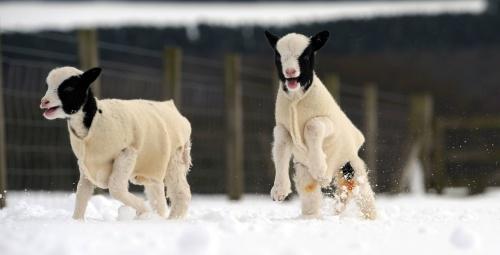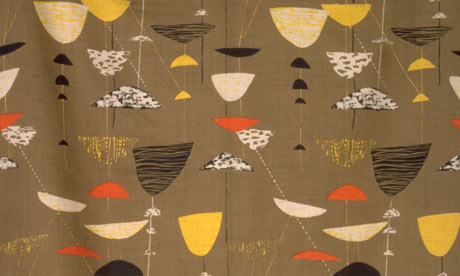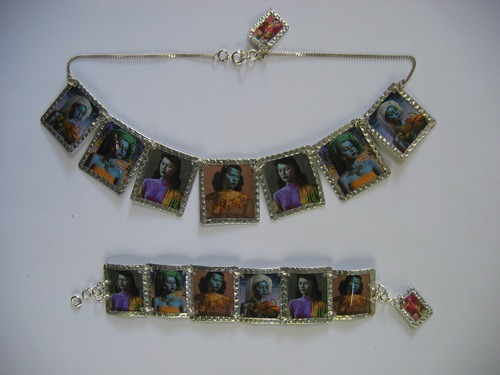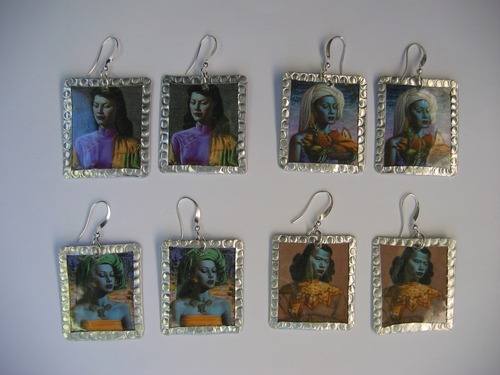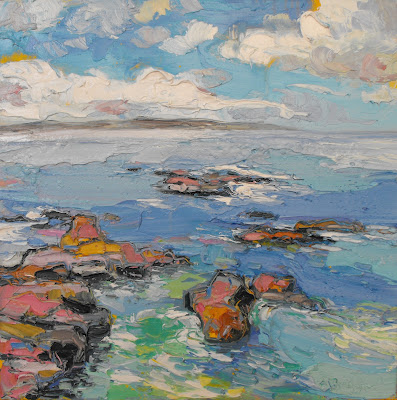Yes, my delivery of The Cornish Landscape catalogues has just made it through the snow! It's always an exciting moment when you see the catalogues for a show for the first time.
Wednesday, 27 March 2013
Tuesday, 26 March 2013
Cornish Paintings off to Bristol
My paintings for The Cornish Landscape exhibition have been all parcelled up and are setting off on their journey to the Lime Tree Gallery in Bristol.
Beady-Eyed Gull, St Ives (Acrylic, 5 x 7)
It's always good to see a huge pile of paintings finally set off on its journey to the show. There's not many jobs when you have such a definitive end to a phase of work and a tangible, physical result.
The next part of the process will be next month when I see them hung in the exhibition in the gallery. Somehow they take on whole new feel when you see them in the show - they're all big and grown up, and they're not the same as when they were just in the studio.
Of course, they'll be alongside the wonderful new work from Euan McGregor and Peter Wileman, so all the paintings will be working in a whole new way with the others as a group.
Calm Sea at Dawn, St Ives (Oil on linen, 24 x 26)
Friday, 22 March 2013
Art or Kitsch?
Recognise this?
It's Vladimir Tretchikoff's Chinese Girl, thought to be the world's most reproduced print. It's an icon of 50s kitsch.
Here's the original painting going under the hammer this week at Bonham's auction house in London.
(AP Photo/Bonham's-Giles Peppiatti-HO)
Some might not even consider this to be 'real' art, but guess how much it went for? £982,050 ($1.49 million). That's more than twice as much as a Tretchikoff work has sold for before.
It was thought the famous turquoise-faced lady would fetch £500,000. However a bidding war broke out, and it was bought by British businessman and jeweller Laurence Graff and will go on public display in South Africa.
According to a Bonhams representative, the painting will be
exhibited alongside the rest of the diamond retailer's art collection,
at the Delaire Graff Estate in the Western Cape.
Tretchikoff, who grew up in Russia and Shanghai, eventually
settled in South Africa in 1946, so in a way the painting is going home. Here's the man himself in action.
Tretchikoff Foundation
The model was Monika Sing-Lee, then 17, whom Tretchikoff spotted working at her uncle's launderette in Cape Town in 1953. Here she is.
artchantry.com
And here she is rather older, wearing the same top (the artist changed the colour in the painting).
Apparently she sat for him for six weeks, and got paid 20 rand (£6.50). (Read more about her here) .
In his 1973 memoir Pigeon's Luck, Tretchikoff said he had put
his "heart and soul" into the painting he hoped had "caught the essence of
Chinese womanhood". Monika said that the whole experience was so intense and he was so nice to her and so funny that she nearly fell in love with him during the sittings. You can see why...
Tretchikoff Foundation
She never sat for him again, but with her turquoise face and ruby lips, it's certainly a memorable image. Why was it so popular?
I guess because it caught the mood of the moment. It certainly had the sort of colour palette favoured by post-war 1950s textiles
Lucienne Day, Calyx textile
so it fitted right in with the home furnishings, bringing an exotic and
daring touch to a dull suburban home, like a plastic pineapple ice bucket in
the drinks cabinet.
It had a certain carefree, pre-psychadelic, aspirational quality - after the trauma of the 40s, it was a completely off-the-wall, playful image. It wasn't a wartime poster where someone was telling you to keep calm and carry on or only cough into your handkerchief. It was just a frivolous, bonkers image, one you chose yourself, and one day, you might save up to go to somewhere as exotic as the place that girl came from, where maybe they all had pretty turquoise faces.
The popularity of Chinese Girl led to Tretchikoff, who died in 2006, being labelled the "king of kitsch" - though his Foundation describes him as "the people's painter".
"Vladimir Tretchikoff inspires us" says the Foundation's website, "with his uncompromising and pioneering spirit, indomitable self belief,
his originality, his courage and by his all en-compassing drive to do
what he loved to do - paint." The Foundation's aim is to "ignite as many courageous, creative hearts as possible through
continually communicating Tretchikoff's maverick spirit which is best
captured in his quote "Express your passion. Do what you love. No matter what.""
So there you are. And if you've been ignited, then although you can no longer get your hands on the original, you can still adorn yourself with the image...
Beverley Price Icon Image Jewellery more details, click here,
Thursday, 21 March 2013
Paintings of Godrevy
I thought I'd show you some of my paintings of Godrevy from my Cornish exhibition.
Godrevy is a popular surfer's beach near St Ives. It has sandy beaches and high cliffs - although the first time I went there, I couldn't see a hand in front of my face because the sea mist was so thick!
However the next day was beautiful sunshine and blue skies - such are the vagaries of the Cornish weather!
Ideal painting conditions!
Green Sea, Godrevy (Oil on linen, 20 x 20)
The lighthouse is said to have insipired Virginia Woolf's To the Lighthouse.
Godrevy Lighthouse (Oil on linen, 12 x 12)
Godrevy with Yellow Flowers (Oil on linen, 20 x 20)
Tuesday, 19 March 2013
Cornish Landscape Catalogues
The catalogues for April's The Cornish Landscape exhibition are just being finalised.
Here's a quick look at the front cover, which shows my painting of Land's End.
Here's a quick look at the front cover, which shows my painting of Land's End.
Monday, 18 March 2013
Camera Disaster in the Lakes!
The weekend found me in a rather wet Lake District to do some photography along Derwent Water at Keswick.
As usual, I was using my Canon Powershot G12, when I ran in to some problems.
The zoom function (one of its main plus-points) began to play up. It wouldn't zoom. Thinking I'd accidentally knocked some sort of setting, I tried to check the menu, but the menu button wouldn't work either. It seemed to be stuck on trying to calculate the focus, and wouldn't take the photo. The camera hadn't got wet or anything, it had just stopped working.
Checking online later, it turns out that a number of people have also experienced this problem, read here. Annoyingly, it can be intermittent, and seems to be caused by sticking buttons. Now if you can't take a shot with a camera, then you've missed the shot. It's no use having an intermittently working camera, and I can't find a way of getting it to definately keep working again.
So here's my advice.
1. always take a spare camera, and take shots with that camera as well. Then you'll have two sets of reference material (or one if one camera gives up). Take cameras that have different functions to the other, eg a bigger zoom, different filters, larger sensor.
2. always take a spare battery (charged).
3. always take a spare memory card. Or two.
4. always take a spare assistant to take different photos of the same scenes. (Unfortunately, I didn't have option 4 at the weekend...)
And if you've had similar G12 problems, and can offer advice/solutions/a shoulder to cry on, I'd love to hear from you.
Thursday, 14 March 2013
Paintings on Show in Suffolk
I've got paintings opening in an exhibition in Long Melford in Suffolk at the weekend.
It's a show of Scottish women artists, and includes Mhairi McGregor, Annette Edgar, Claire Harrigan and Emma Davis, amongst others.
The show opens on Saturday 16th March at the Lime Tree Gallery.
For more information and to see all the work in the show, click here.
Setting Sun near Stafford (Oil on linen, 20 x 20)
It's a show of Scottish women artists, and includes Mhairi McGregor, Annette Edgar, Claire Harrigan and Emma Davis, amongst others.
The show opens on Saturday 16th March at the Lime Tree Gallery.
For more information and to see all the work in the show, click here.
Wednesday, 13 March 2013
Paintings of Cornwall
I'm just finishing preparations for a show next month of paintings and drawings of Cornwall.
It's a very exciting show with two other artists, Euan McGregor and Peter Wileman, at the Lime Tree Gallery in Bristol, called The Cornish Landscape.
I travelled round Cornwall last summer, and the result is a series of oil paintings, drawings and postcard sketches of the county.
I love Cornwall, and I wanted to get a sense of a place that's very much on the edge of things, surrounded by the sea. It's also a landscape that has been shaped by the people that have lived there before, whether it is ancient Celtic monuments, the ruins of the tin-mines, or a place where artists such as Peter Lanyon or Barbara Hepworth have been and interpreted in their work.
Portheras Cove, (Oil on linen, 32 x 32)
This is a painting called Portheras Cove. You have to walk a long way on a path that goes up and down the cliff to get there, so it's not easy. It's a beautiful beach (although there are dire warnings not to walk in bare feet because there is metal from shipwrecks under the sand!).
I
wanted to do a series of paintings of places that are secret and
discovered, coves that are like the places that you remember from
childhood - somewhere special and exciting with just the sand and the
sea, full of the possibilities of adventure.
The show opens with a preview on Saturday 13th April.
Tuesday, 12 March 2013
Off to Keswick
I'm off to the Lake District later in the week (snow permitting!) to take some photographs around Keswick.
My paintings at my solo show in London seemed to really strike a chord with people, so I thought I'd take the opportunity to return to the Lakes with my camera.
Fingers crossed for some pre-Easter sunshine!
Friday, 8 March 2013
"Scotland's Foremost Watercolourists"
Here's my painting at the Royal Scottish Society of Painters in Watercolours in the Royal Scottish Academy in Edinburgh, described as an exhibition of 'Scotland's foremost watercolourists'.
(I'm in the centre, at the top.)
Thursday, 7 March 2013
Turning Landscape Art on Its Head
This is Horatio McCulloch's painting Loch Maree.
Horation McCulloch, Loch Maree (Oil on canvas, 1866)
It's a fine traditional, Scottish Victorian painting, by a fine, Scottish, Victorian painter.
Here is Mr McCulloch, looking every inch the fine, Scottish, Victorian painter.
Photograph of Horatio McCulloch (Hill and Adamson, 1847)
And here's Loch Maree. You can see that in order to step up the romantic Highland drama (Salvator Rosa has a lot to answer for), Mr McCulloch accentuated the ruggedness and the steepness of the mountains as they rose out of the loch.
However, to today's tastes, it's quite a brown, dull, old-fashioned painting.
So how do you make a dull, brown old-fashioned painting look exciting and new in a gallery today?
By doing this, apparently.
Picture: Colin Mearns (The Herald)
Yes, by hanging it upside-down.
Although it's not just an upside-down Horatio McCulloch any more. Oh no. This is now an installation by the artist Rachel Mimiec entitled 'A Pause of Pages: Reflection on the Practice'. It's currently on display at the Gallery of Modern Art in Glasgow, and has 'attracted excitement', according to The Herald newspaper.
"Once it's been hung upside down like that, you are being forced to notice details about it that you haven't seen before," said 'A Spokesman'. "And also when it's upside down you are not looking at what's being painted so much as how it's being painted."
When I took life drawing classes recently at the St Ives School of Art, our model did the final long pose upside down for that very reason - it meant that we were forced to consider her body afresh, to go beyond what we know about how things fit together, and to see her as a shape, a volume, a movement, a feeling, a still life, a pattern, a sculpture, a texture.
Drawing a nude is about far, far more than clinical measurement and exact representation. As well as being a representation of another human being, it's also a self-portrait of the artist, as well as a dialogue between the model and artist. A good model won't just hold a pose, they'll give you a pose.
It's not a medical text-book illustration, with exact muscles and joints. It's a feeling, a moment. When we were in the life-drawing room in St Ives, we could hear the sea, and the sun was setting, and it was beautiful, and as an artist, that's the sort of sense you have to put in the drawing.
The same goes for landscape. Loch Maree isn't just about a representation of a place, although you can actually go there and still see the scene that McCulloch painted. It's about the time and the values - social, moral, economical, political - in which McCulloch lived, and which moulded him as a person, and also about him as a person. Have a look at that image-moulding photograph setting him out for posterity. He's quite a rugged, romantic looking guy. There's quite a sense of brooding intensity going on there, like the scenery.
So I'll leave it with you about the upside-down paintings. I'm all for anything that makes you look afresh at an unfashionable painting, especially if it's a landscape one, because landscape has to run the current gauntlet of being an untrendy, unhappening genre. Which, if you saw the Hockney Royal Academy show last year, is blatently a load of old nonsense.
It's just that the expressive potential of landscape is a bit too subtle for today's tastes. It's not an in-your-face diamond-studded skull. As a viewer, you have to work with landscape.
Wednesday, 6 March 2013
Off to the Affordable Art Fair
Well, as one door closes, another one opens, and today my paintings are off on their travels to the Affordable Art Fair in leafy Battersea Park in London.
The fair opens tomorrow and runs until Sunday. With all art priced at under £4000, and with over 100 galleries, free events, and a very nice cafe, all in the setting of a tent in Battersea Park, it's the perfect spring day out.
And you get to see my paintings on the Duncan R Miller Fine Arts stand as well...
Hedgerow, Ulster Way (Oil on linen, 32 x 32)
Tuesday, 5 March 2013
What's it Worth?
These paintings by artist Lewis Todd are about to go up for auction, and are expected to be sold for around £100,000.
None the wiser? Not seen anything you'd like to hang on your wall?
It's because Lewis Todd's Sunday paintings were painted on the good side of scraps of canvas that was given to him free to practise on. And on the back are parts of Francis Bacon's Screaming Pope series.
Now you may not have heard of Lewis Todd. And you may be wondering why his work is worth thousands.
Well, it's not because of the front of his paintings. It's because of what's on the back.
None the wiser? Not seen anything you'd like to hang on your wall?
It's because Lewis Todd's Sunday paintings were painted on the good side of scraps of canvas that was given to him free to practise on. And on the back are parts of Francis Bacon's Screaming Pope series.
Francis Bacon - Pope 1 = Study After Velazquez Pope Innocent X (Oil on canvas, 1951)
After the Second World War and short of funds, amateur painter Lewis Todd was encouraged to take
up painting in oils by John Kesterton, manager of the Heffer Gallery,
who gave him his first canvases free because they had only been used on
the reverse by Bacon, whom the gallery also supplied with materials. Bacon liked to paint on the unprimed back side of the canvas, in a conservationists nightmare, but it meant that the front side was perfectly suitable for painting on.
The gifts were conditional upon Todd agreeing to cut up the canvases before making use of them for himself. It is not known how Bacon’s used canvases came to be at the Heffer Gallery in the first place, but Bacon was well know for discarding and mutilating his work.
The gifts were conditional upon Todd agreeing to cut up the canvases before making use of them for himself. It is not known how Bacon’s used canvases came to be at the Heffer Gallery in the first place, but Bacon was well know for discarding and mutilating his work.
If you've ever seen the reconstruction of Francis Bacon's studio in the Hugh Lane Gallery in Dublin (as I have), then you can see that he worked in a very chaotic and crowded environment. So it's no wonder that he discarded canvasses that displeased him. He probably just wanted them out of his creative space, which was full to bursting. There were already 100 slashed canvases found in his studio on his death, like this one.
Francis Bacon - Slashed canvas - Study for Man with Microphones, 1946.
Collection Hugh Lane Gallery © The Estate of Francis Bacon
So how valuable is a part of a painting? Who wants to have only a piece of the whole? Is the value not in the total image, the complete concept, the entire vision of the artist? Or is it enough to own just a fragment, like a religious relic? Is having a few marks on a canvas that has been touched by Bacon enough, rather than the painting itself? Is it more about the cult of the artist rather than the meaning or aesthetic pleasure of the object? Or is it merely that even Bacon scraps become a trading commodity?
A whole Bacon Screaming Pope is worth around £5 million. Five of the Lewis Todd canvases have been authenticated by the Francis
Bacon Authentication Committee and will be sold by Surrey auctioneers
Ewbank's on 20 March.
Interestingly, Ewbank’s Auctioneers are credited in having established the market for
previously unseen and mutilated Francis Bacon canvases. In fact, it's become quite a lucrative market.
In 2007, they
sold a collection rescued from a skip outside the artist’s London studio
by electrician Mac Robertson, who became Bacon’s drinking partner.
Estimated at around £50,000, the collection sold for £1.13 million.
A further six works which were sold by Ewbank’s on behalf of Ron Thomas, a porter at Bacon's dealers, Marlborough Fine Art. One of Mr
Thomas’s duties was to ferry paintings between the gallery and Bacon's
studio and the mutilated canvases were given to him, either to keep or
to have the stretchers for his own use. They sold for a total of
£32,000.
In 2008, a man who worked in the shop where Bacon purchased his art materials, consigned part of one of Bacon’s destroyed canvases dating from about 1985. It showed what appeared to be a “pool of flesh” spread across a black background, and sold for £12,000.
In 2008, a man who worked in the shop where Bacon purchased his art materials, consigned part of one of Bacon’s destroyed canvases dating from about 1985. It showed what appeared to be a “pool of flesh” spread across a black background, and sold for £12,000.
So have a look at the back of paintings. They could be more valuable than the front.
Monday, 4 March 2013
Last Day!
It's the last day for my solo show in London.
I'm quite sad as I thought it
was a really strong exhibition. It's always really special to see the fruits
of your labours hung together as a cohesive group, all in their
smart frames, rather than as an idea you've been keeping in your
mind's eye for many months.
Still, that's it all over for another year!
Subscribe to:
Posts (Atom)

